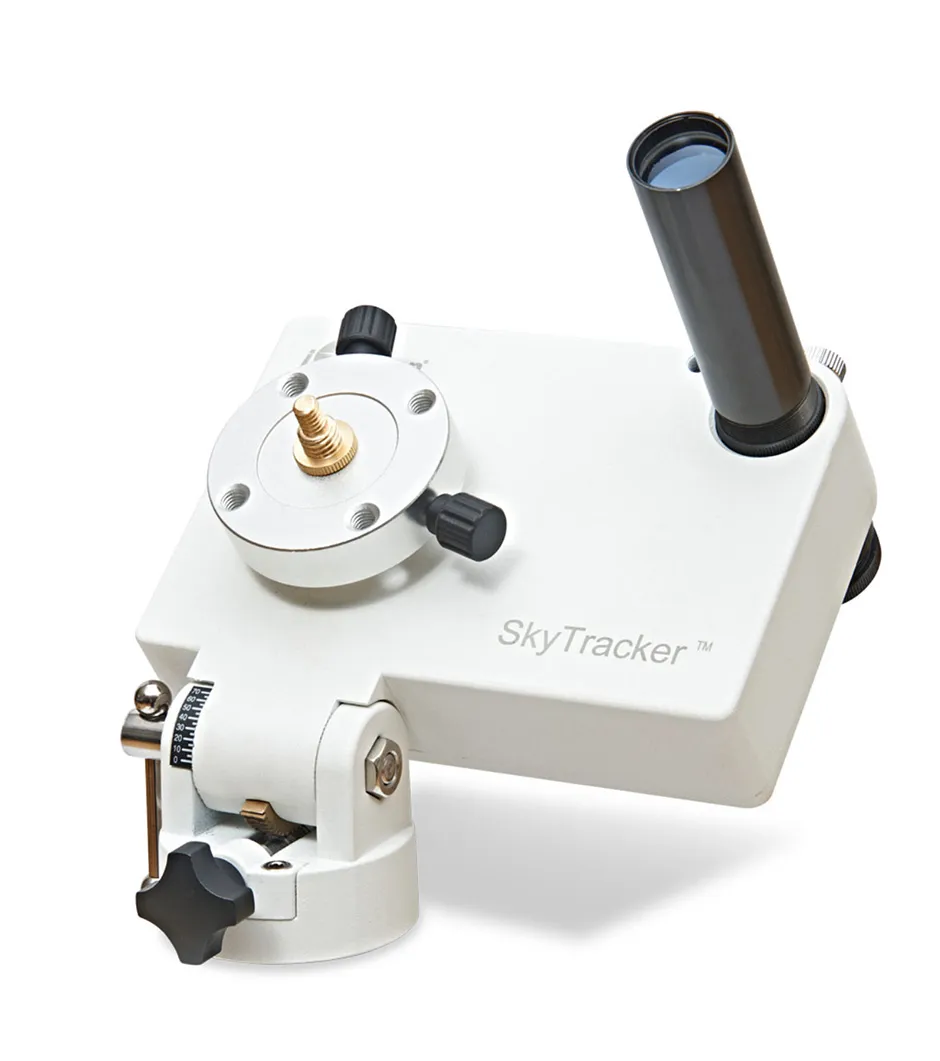Capturing tracked, wide-field images of the night sky with a DSLR camera is very rewarding, especially if you manage to record the grandeur of the Milky Way.The latest tracking mount from iOptron, the SkyTracker, will help you to do this.
It is fitted with an illuminated polarscope for accurate polar alignment, a latitude adjustment knob with a graduated latitude scale and an integrated compass and spirit level.It also comes with a padded carry case.
The mount can be powered by four AA batteries (not included), which can give up to 24 hours of use depending upon operating circumstances.
Alternatively, there is also a power connector for a separate power source, so a portable power tank can be used in the field.
Near to the connector is the on-off switch and two further switches, one for selecting northern or southern hemisphere and the other for 1x or 0.5x sidereal rate, sidereal rate being the speed at which the stars appear to move across the sky.
We were also supplied an optional iOptron SkyTracker DSLR ball head for the purposes of this review.
The SkyTracker is attached to a tripod via a standard 3/8-16 threaded socket; if your tripod has a 1/4-20 screw you will need to purchase an adaptor.
We then attached the DSLR ball head and to that we attached our camera.

The mounting block has a reversible 3/8-16 and 1/4-20 screw so you can attach your chosen ball head regardless of its screw thread.
The SkyTracker can hold up to 3kg in photographic equipment; it was easily able to hold our Canon EOS 50D and a heavy 70-300mm lens, as well as our lighter 18-55mm lens for wide-field imaging.
Alignment adventures
We found the integrated compass useful to roughly find north.Although there is a basic sight hole for rough polar alignment, the illuminated polarscope improved tracking by allowing us to more accurately line up with Polaris.
You can improve alignment further with another optional extra, iOptron’s iPhone and iPad polar alignment app, which tells you where to position Polaris in the polarscope for your latitude, time and date; note that the app isn’t compatible with other smartphones or tablets.
The in-built compass also has an integrated spirit level, which we found did a poor job – the bubble could not reach the central part of the dome due to the spindle of the in-built compass.
Instead we used a small spirit level on the top to ensure the system was level before adjusting the latitude knob for our location.
Once set up with our camera and wide-angle lens attached, we were able to take five minute exposures without tracking errors using the 18mm lens.
We were also able to get good results with pinpoint stars when we switched to our 70-300mm lens and set it to 300mm.
With our Canon EOS 50D and its APS-C sensor, this actually equates to a 480mm lens.We targeted the bright star Regulus in Leo and took a 30-second exposure with no tracking errors.
Bear in mind an untracked image normally shows star trails at exposures just longer than 1 second, so this is a vast improvement and allows you to image the brighter deep-sky targets – especially if you stack multiple exposures.
There were a couple of considerations to take into account.
When the camera was on the eastern side of the mount it tracked better than when it was on the western side, where the weight was pulling the setup down.
We also noted that if you change lens or move the camera so that it points at a different area of the sky, it is well worth checking the polar alignment in case it had been moved in the process.
There is no doubt in our minds that iOptron is onto a winner with the SkyTracker.
Vital stats
- Price: £350.00
- Weight: 1.1kg
- Supplier: Altair Astro
- Telephone: 01263 731505
- Website:www.altairastro.com
